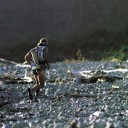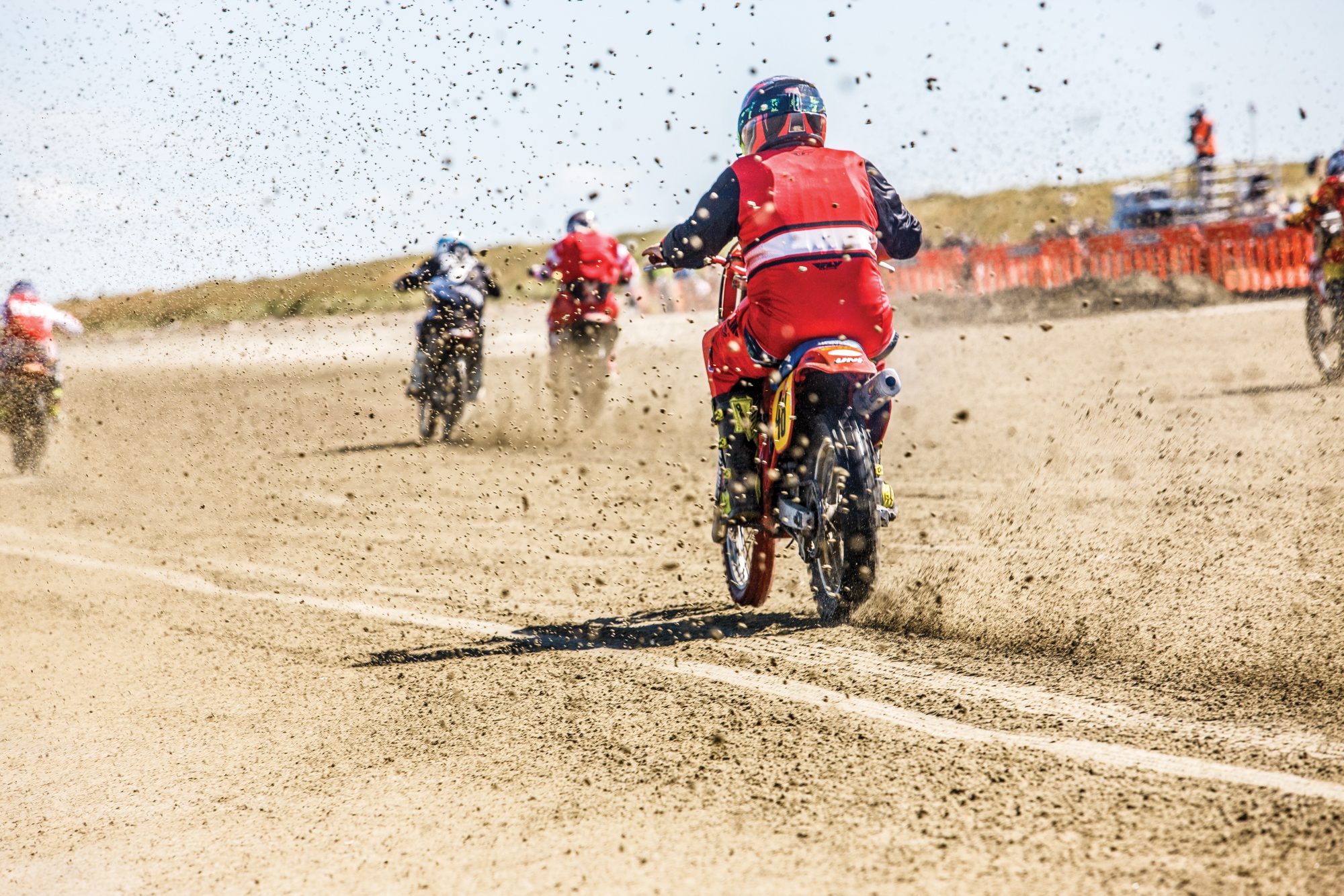
Doing the Burt
For one fossil-fuelled week every summer, anyone can be an Invercargill motorcycling legend.
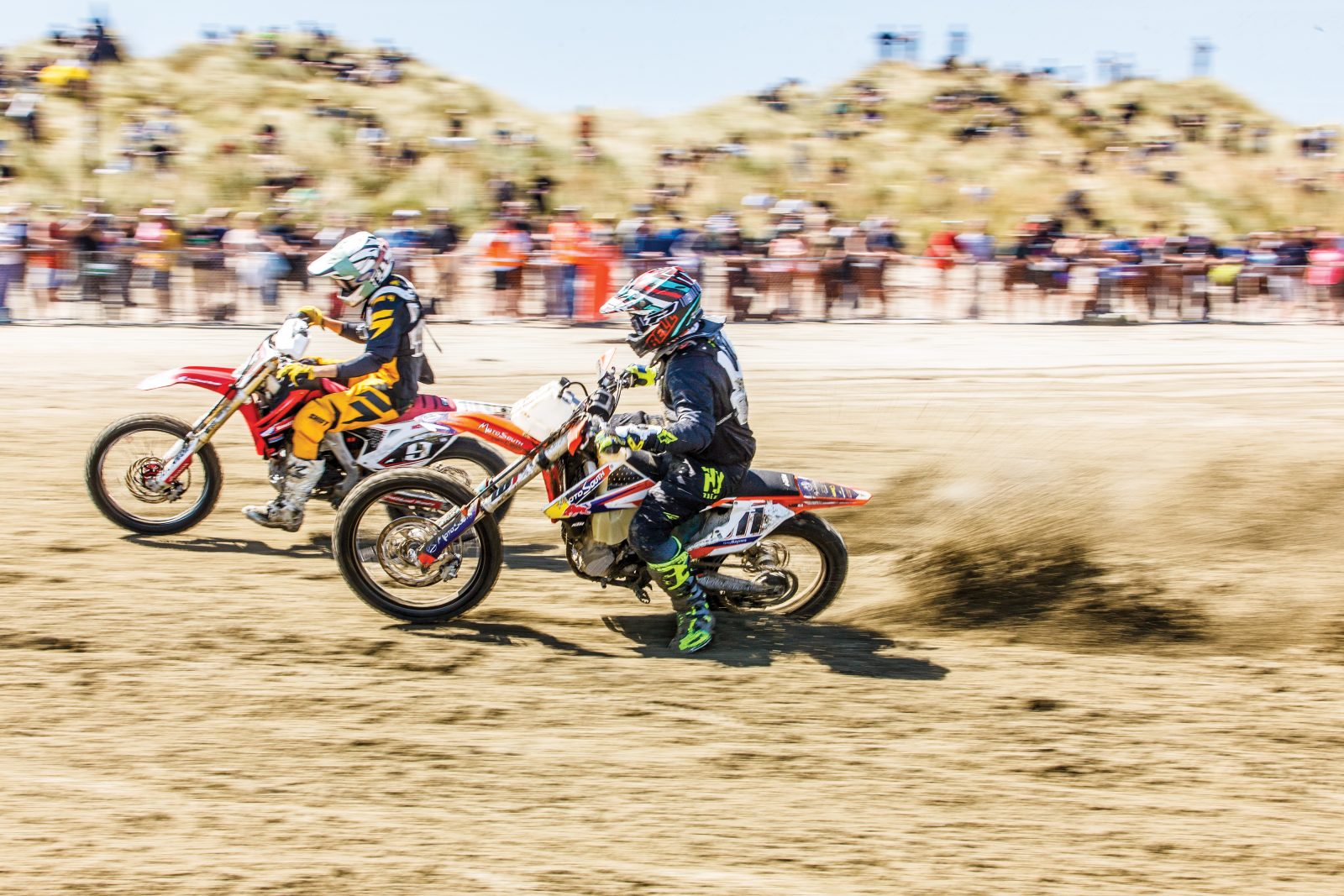
The speed limit on Oreti Beach is 30 kilometres per hour. On any other day, that is.
Right now, the limit is based on whatever grip you can eke from the friable sands, and the size of your cojones.
Nine riders roared away from the start of the Burt Munro Trophy beach race, bikes bucking, front wheels lifting with the brawling hunger to win. Now, 43 miles later (this race is stubbornly imperial at 50 miles), there are just four left, scouring the course for hundredths of seconds. One powers through the shallows, seeking some advantage in the firmer sand. But the race will be—and always has been—won in the turns: one at each end of the mile-long circuit.
If you want to prevail in beach racing, you must be comfortable with the back end of the bike trying to overtake the front. Indeed, you encourage it, leaning the bike into the turn, hard, so that only the very outside tyre knobs are clawing at the beach. Then you caress the throttle, holding the machine on the edge of chaos, stretching the laws of physics. You push your weight forward and make a tripod, sticking your inside leg stiffly into the turn, heel skimming the sands. You come in wide, before cutting the apex so fine you almost clip the lenses of the photographers in the media box. That’s enough finesse: now it’s about brute force. Get your weight back, wrench the throttle wide and let the bike thrash and buck its way upright and onto the straight.
Slow in, goes the motocross mantra, fast out. But today is race day, and the loser is the guy who brakes first. After nearly 45 minutes, Greg Baynes has stolen 18 seconds from Jason Feaver, every one of them hard-won. These two are so fast, so determined, that the rider in third place is five laps behind.
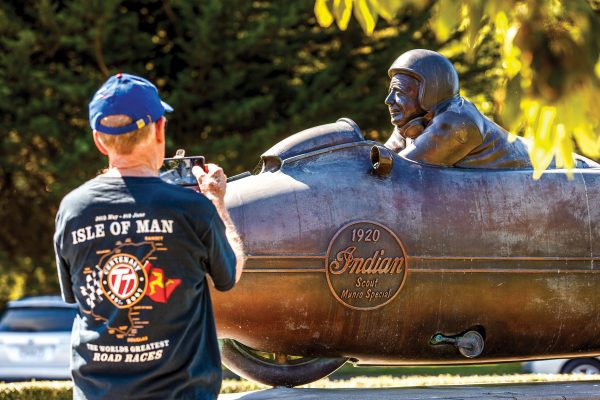
For these racers, and the 500 or so spectators who’ve come to watch them, these are hallowed sands. It was right here at Oreti that legendary Kiwi motorcycle racer Herbert ‘Burt’ Munro, Invercargill’s favourite son, whipped his 1920 Indian Scout to ever-greater speeds as he prepared for a crack at the under-1000cc world speed record.
Out of the crate, Munro’s bike could do 88.5 kilometres per hour. It took 20 years of long, laborious nights, countless failures, and the unfailing generosity of mateship before he wrung 295.453 kilometres per hour from it—in 1967, at age 68.
That was more than enough to clinch the record. In 2014, his speed was revised to 296.259 kilometres per hour, after a calculation error was rectified. It still stands.
I’m looking at that bike right now. It sits behind safety glass in E. Hayes & Sons, a hardware store on Dee Street, Invercargill. Easily half of the store’s 5500 square metres are devoted to the display of 63 classic motorcycles, sorted into decades, as well as classic cars and sundry mechanical curios. The 1960s section has displaced the lawnmowers, which have been forced into vertical stacks. There are Harleys in the homewares, Triumphs along the tool wall.
The place is packed, and most of the punters are wearing leathers. They’ve come from all over to gaze upon these antiquities. Some squirm into the aerodynamic shell of a nearby replica of Munro’s bike—made for Roger Donaldson’s 2005 biopic, The World’s Fastest Indian—for a contorted selfie.
“Until we put a visitors’ book on the counter,” says managing director Neville Hayes, “we didn’t even know Invercargill had a tourist trade.”
Hayes is the fourth generation to run this family business, started by his great-grandfather in 1932. His dad, Norman, was a good mate of Munro’s, so Hayes knew him, too.

“In 1977, Burt spent five weeks in hospital after a stroke. When he came out, he had no co-ordination or concentration, and he knew he’d never pass a medical to race again.”
Munro told Norman that he wanted all his belongings kept in one place, safe from trophy hunters and freely available for the public to see.
“He knew his number was up,” says Hayes, “so Dad and I bought the bikes and all the other stuff that came with them. He wanted $1300. That was Burt’s price, and we just paid it—half each. That was the 15th of September, 1977.”
Munro died less than four months later. The promise has been kept: “All his stuff is in trust,” says Hayes. “It’ll never be sold.”
Here are Munro’s goggles, perhaps the most poignant keepsake in a cabinet lined with trophies, pistons, conrods and a modified aircraft engine cylinder head. It’s a chronology, written in metallurgy, of perseverance, failure and occasionally triumph.
The special parts Munro needed didn’t exist, so he made them, filing them to exacting specifications with hand tools, a fraction of a millimetre at a stroke.
He carved conrods from truck axles. He cast his own pistons with a kerosene blowlamp. Very often, they failed. Here’s one melted beyond recognition, there’s a conrod snapped in two. ‘Offerings to the God of Speed’, reads a hand-painted epitaph. After every dispiriting bang, Munro went back to his bench and started again.
[Chapter Break]
For motorcyclists, this whole week is something of a religious holiday here in Southland. It’s February, and the Burt Munro Challenge is back in town. An idea of the Southland Motorcycle Club, the Burt’s first flagfall came in 2006, catching a wave of Munromania triggered by Donaldson’s film. Now, it’s the biggest bike bash in the Southern Hemisphere, drawing more than 3000 riders and spectators.
Its hub is a sprawling tent city at Otatara, not far from the beach, where more than 2500 campers are trying to dodge an un-Southland-like heatwave. Some have come from Australia, others from Britain, the United States, Ireland, and even Italy.
In town, accommodation is booked solid—boutique and backpackers’ alike. Motorcycle parking is overwhelmed, so footpaths are monopolised by ranks of hogs, adventure bikes, choppers, cruisers, cafe racers and classics. There are motorcycles in the town square, on the verges, and lined like dominos outside hotel lobbies. Always, everywhere, the thunder of engines echoes off the concrete.

On Tay Street, car parking has been appropriated to make room—still insufficient—for pilgrims’ mounts outside Motorcycle Mecca, a bustling art-deco cafe and museum with two floors of all things motorbike.
By lunchtime, the cafes start to empty, and the bars begin to swell. Everybody—and I mean everybody—is wearing black, and the dress code of some of these places apparently prescribes Dirty Dog sunglasses, too. Leathers are mandatory, and t-shirts must, above all, indicate which of the other important motorcycle runs you’ve attended since 1980. The Brass Monkey is a particular badge of honour, but the Dusty Butt, Sound of Thunder and Teddy Bear Runs will all get you in the door.
Munro was a man who spent much of his life penniless (after he split with his wife, Florence, in 1947, he threw in his job and lived in his workshop) so it’s hard to know what he would make of the commerce conducted in his name. There is Burt merchandise, Burt burgers, and many businesses are running ‘Burt hours’. The Throne Room tattoo parlour offers a Burt Munro special, and Indian motorcycle motifs are in hot demand. The waiting area is full, and the owner tells me this is one of his busiest weekends in a long while.
Likewise, the guy behind the counter of the Wetlands Bottle-O liquor store, providentially sited nearest to the Rally Camp at Otatara, says Burt sales come second only to Christmas. (The Invercargill Licensing Trust confirms this statistic holds true citywide.)
You get a sense that some tribal rivalry has been suspended. Photographer Rob Suisted—himself a mad keen adventure biker—points out that Harley riders “won’t normally give you the time of day, but down here, everyone waves to everyone”.
Riders are even chatting with motorcycle cops, and I notice that unattended bikes everywhere are decked with expensive helmets and jackets, left behind in implicit trust.
Shannon the taxi driver says he’s never had any trouble from Burters.
“They seem like lovely people. We get more trouble on Ascot race day.”
Pete Graham, acting inspector at Invercargill’s central police station, agrees. He’s been involved with the Burt from day one, “and we’ve never had an arrest in the history of the event”.
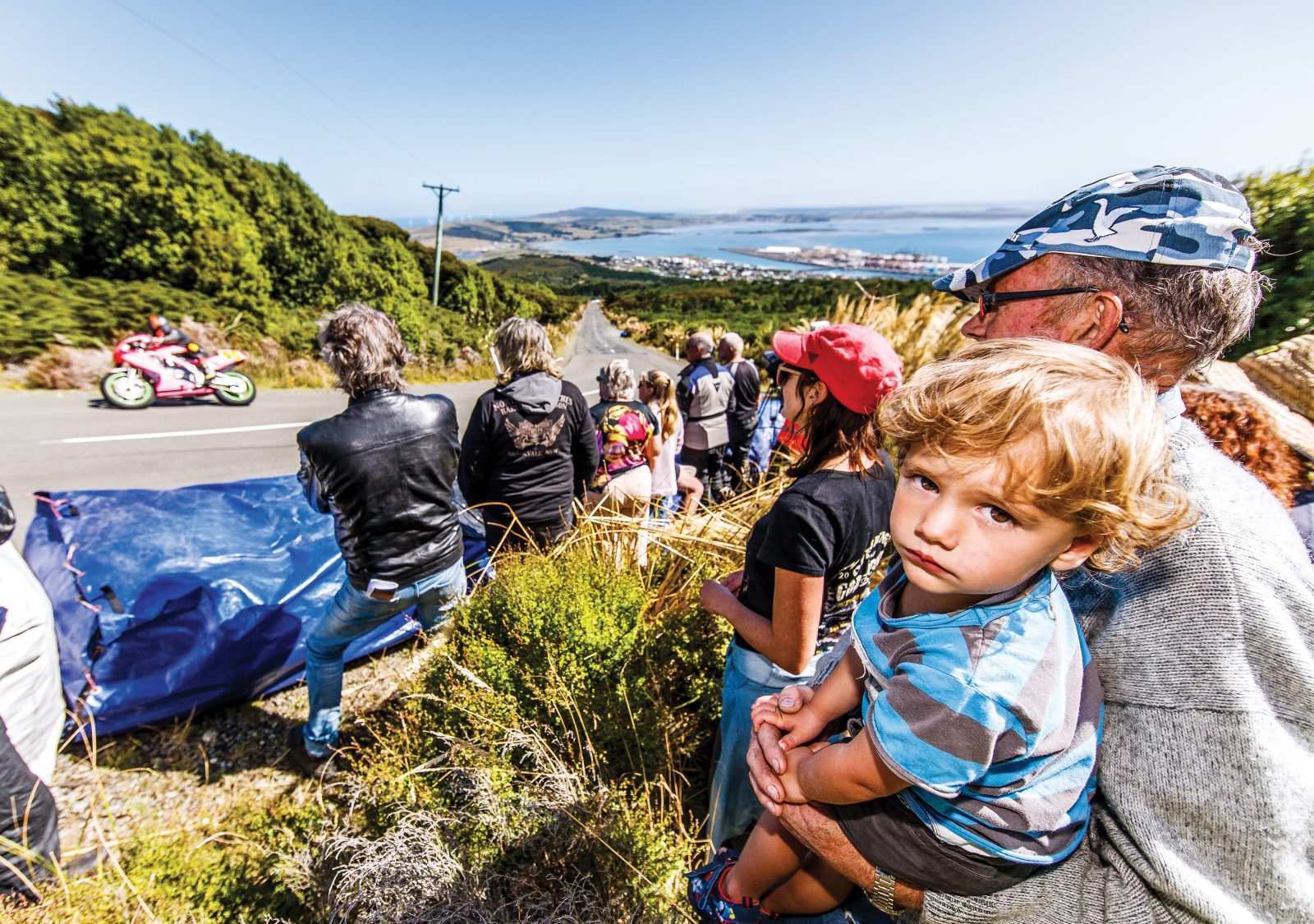

Police do get occasional complaints from motorists about speeding and risky overtaking on Invercargill’s roads, but Graham says party fatigue is his biggest concern right now.
“Many of these guys aren’t used to long, multi-day rides. We’ve had a few crashes, particularly after the event, when riders are tired from the heat, and partying for days. Then they try to ride home the length of the South Island, and a few have come unstuck. We’re doing more to warn riders of those dangers.”
A few gangs rode into town during the Burt, and I ask Graham whether rumours were true of one getting a police escort back out again.
“Let’s just say they didn’t get the customary southern welcome that other attendees get.”
Otherwise, the air is heavy with camaraderie, and many riders will tell you that’s why they’re here. Everyone’s bike-watching. A group of people propped against a table outside Waxy’s Irish Pub are craning to see the source of a particularly affronting exhaust note at the lights. When a Harley—I know not which kind—materialises, there are murmurs of confirmation and approval.
“We’re all here for the same reason,” says one, who wants to go on the record as Booza: “a love of bikes. I even rode a BMW the other day.” This is plainly one of the funniest gags the group has heard in some time.
“When we’re down here, we’re all just one big family, having a good time,” says another, who calls himself ‘T.H.E.’ (“Don’t ask,” he tells me, “it’s a long story.”)
T.H.E. remembers watching Burt Munro race at Ashburton in 1976 in steel-capped boots: “I was 16 at the time, and I’ve never forgotten it.”
[Chapter Break]
On Saturday night, I hold my nose and go to the Burt Munro Speedway Spectacular. I’m here because I loathe speedway, and I want to find out why other people love it.
Speedway is beach racing in a stadium, with hot dogs. The oval circuit is shorter, as are the races—just three laps. That’s because it’s one of the most physically demanding ways to wrestle a motorbike, which is saying quite a lot.
“Speedway is like a fight,” says Burt legend and martial arts master Kevin Ryan. “It only lasts 80 seconds, but you come in dry retching and completely f—ed.”

Ryan, 55, shirtless and shaggy, does the Burt from the back of the same bus he normally lives in back at Barrytown, north of Greymouth, fitted out from pallets and packing crates. His motorcycles get roughly as much room as he does.
“When I was 20, I bought a P120 Bonneville, and I still have it. Over the next 30-odd years, I accumulated a mountain of spare parts, so I shined them all up and called them a race bike.”
Ryan is one of the few who’ve raced every Burt. The first year, he rode only speedway, but ever since, he’s ridden every event—or tried to. His smile is the more winning for the absence of a couple of front teeth.
“I’ve probably laid in more gutters around Invercargill wrenching spanners than actually finishing races. One year, I thought, ‘I’m gonna build a motorcycle that doesn’t blow up.’ I spent everything I had. I came back the next year, and I lay in the gutter wrenching spanners. Nothing changed except my bank account.”
He races everything on just two bikes, which means that, when the chequered flag falls and everyone else goes for a beer, he goes back to the bus and starts work.
“My drag bike uses my speedway motor, so I have to pull the motor out of my speedway bike, put it into that, do the drags, then put it back into the speedway bike and go race. I’m always doing whatever it takes to make the next race.”
Everyone knows Ryan, so he has a de facto pit crew of hundreds.
“I’m always borrowing bits and pieces, and if I can’t get my bike going, guys will offer me something to ride. The way they see it is: ‘If you haven’t got your bike going, then how am I going to race you’?”
Strewn blithely about is a jumble of trophies. In 2008, and again in 2010, Ryan won the Munro Family Trophy. Of all the prizes, this is perhaps the most meaningful. It’s awarded to the rider considered to most exemplify its namesake’s spirit of wholehearted persistence and endeavour.
But Ryan downplays his many victories, telling me he comes here mostly for the Invercargillites themselves: “They’re real people. I mean, look at the state of me—people don’t wave to me anywhere else.”
On Thursday, the old Triumph came through. Ryan placed second in the Bluff Four Square Supermarket Hill Climb, pre-1972 class. Next day, he won the same class at the beach races.
“It’s taken me 10 years to get this running,” he says. “With this engine build, I think I finally got on top of it.”
Next day, he raced the circuit at Teretonga. The bike blew up.
[Chapter Break]
The Oreti Park Speedway stadium is packed with maybe 2000 people. I’m the only one not wearing black. Radio station The Rock is blaring over tinny tannoys, and when Queens of the Stone Age comes on, I catch a whiff of bogan spirit. The sidecars are racing, which is an odd blend of crude technology and reckless tai chi. The co-rider is prosaically called a ‘passenger’ (more colloquially, a ‘swinger’, or ‘monkey’), but that’s a misnomer, because it implies passivity. In fact, the passenger’s job is to stop the whole contraption upending, careering into the barrier, or lifting off altogether, which requires lots of clambering over both bike and sidecar, or hanging off it mere millimetres from the ground. The rider knows where he wants to go; the passenger has to win him the traction to do it.
Sometimes, the passenger gets it wrong. In the Burt Munro Challenge Trophy (“proudly sponsored by Total Conveyors, for all your conveyor needs”), Justin ‘Mango’ Turner and Peter Rintoul end up sprawled beneath their rig as other crews veer around them. This is what the crowd have been waiting for, and they jump from their deckchairs.
“Mango, that’s not how you do it, mate,” chides the commentator. The pair are fine, and so is the bike: they flip it back on its wheels, fire it up and roar off to cheers and pumping fists.
There are further incidents. In fact, a race in which the whole start list crosses the finish line undisqualified turns out to be an aberration, but none of it alters my view of speedway.

Booza is trying to change my mind: “It’s all about the danger. You’ve got no brakes, and things can go wrong real quick.”
I point out that running with scissors is dangerous, but that doesn’t make it a spectator sport. He tries again, almost imploring now: “It’s the noise, and the smell—that smell of methanol would put a horn on a jellyfish.”
One man’s stench, it seems, is another man’s stimulant.
Kevin Ryan’s bike keeps going long enough for him to win the Classic Solo—he is the only one to finish who wasn’t disqualified. I make my way back to my car, through a maze of motorbikes. I still hate speedway.
[Chapter Break]
For many, the Burt is a sort of sanctuary, a haven where the rest of the world and all its demands and responsibilities fall away.
Rob Duncan is an affable dryland farmer from Wee Waa, 440 kilometres northwest of Sydney. His place hasn’t seen useful rain for two years.
“It’s cruel over there,” he tells me. “We’ve got 3500 acres—and 47 cows. We’re cutting trees for them to eat. We usually harvest wheat in October. Last year, it didn’t even germinate. It grinds you down.”
So he did the Burt.
“This has been a real tonic. When you see them going hard at the hill climb, when they’re sideways on the bitumen, you think, ‘I haven’t got too many problems at all—I’m just feeding cattle.’ I was down at the beach races yesterday; I didn’t think about the farm once. And it’s great to be looking at green grass.”
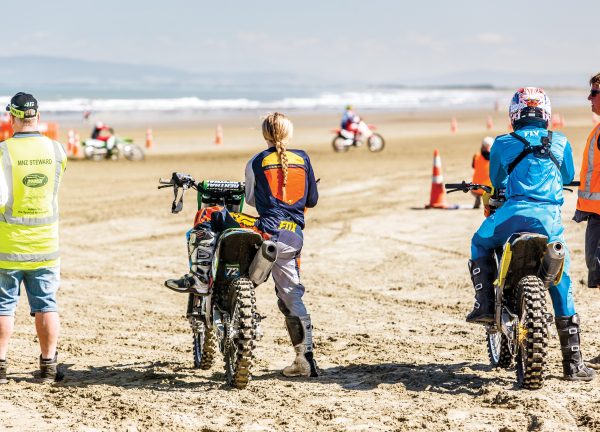
It’s easy to fancy that Munro, too, alone in his workshop, found solace and fulfilment in engine oil, torque wrenches and the concert of internal combustion. I’m one of the countless readers who never finished Robert Pirsig’s Zen and the Art of Motorcycle Maintenance, but I did stick with it long enough to learn that “the test of the machine is the satisfaction it gives you. There isn’t any other test. If the machine produces tranquillity, it’s right. If it disturbs you, it’s wrong until either the machine or your mind is changed.”
Paul Bota knows this. In 2015, his hill climb went tragically wrong.
“I’d just built a new bike, and it was a completely different engine to what I was used to—a two-stroke, and I’m used to riding four-strokes. It was only my fourth ride on it.”
The second he saw the corner, he knew he wasn’t going to make it out the other side.
“I came in too fast and couldn’t commit myself to it. I went straight off the road, with the back wheel skipping off the ground, getting no braking. The bike stood up in a ditch and came back down on my tailbone. I did my L1 and L2 vertebrae.”
He was choppered to Christchurch Hospital, then to Burwood Spinal Unit.
Bota never considered giving up riding. His only concern was that his injuries might mean he couldn’t.
“One day, the nurse came in and said, ‘Okay, you’re getting out of bed now’. I thought, ‘This is never going to happen’, but he said, ‘Don’t worry, I’ve got you’.”
Recovery began with the twitch of a toe: “I went to the pool every day. I got fit again.”
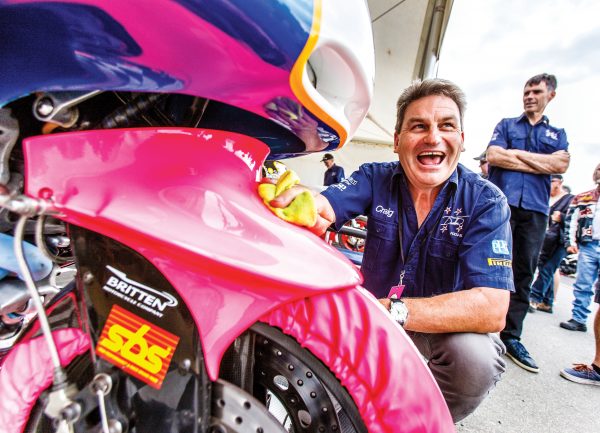
As the long months of rehab went by, Bota knew he needed a focus, a horizon, so he bid on an insurance write-off, a KTM 1290 Super Duke R. As he rebuilt that broken, mangled bike, he rebuilt himself. The machine produced tranquillity.
And now he’s back at the Burt, his ninth, on that beast of a machine, trusting in a back tyre his daughter bought him for Christmas. Thursday, he did the hill climb, and this time, he nailed that corner.
[Chapter Break]
Half the fun of the Burt is getting there. The week prior, all around New Zealand, men and women pack panniers, writhe into leathers, lock the front door and leave behind, for a few days, deadlines, mortgages and the burdens of modern life. On the roads, streams of riders swell into rivers, becoming a flood of thousands as they approach Invercargill.
Colin Halliday packed less gear than most. He turned the pilgrimage into a challenge all its own. Propped next to his pup tent is a tiny Honda CT 110. Just weeks ago, it was delivering mail around suburban Tauranga. Halliday bought it, welded up a 4.5-litre auxiliary fuel tank, then rode the bike, little more than a moped, more than 1700 kilometres, over some of the toughest backroads he could find, to his first Burt.
“They’re surprisingly capable bikes,” he says, “and look how big that seat is—most of that is padding.” Just the same, he admits to the odd sense of ordeal: “Sometimes, when you’re battling a headwind up a hill at 65 kilometres per hour, you do wonder why you’re doing it.”
I ask him whether, now that the joke’s over, next time he’ll bring one of the perfectly good supermoto KTMs he left at home. He grins.
“Actually, I was thinking it would be really funny to ride a postie in some of the events, like the drags. That’d get me the biggest cheer of the day, I reckon. After all, it’s really just about the fun of it.”
He’s waiting on four mates to join him here, all on postie bikes. They plan to head home an even harder way: “We’ve arranged access through some of the high-country stations. We want to do Danseys Pass, and the Molesworth, and maybe the Cape Palliser Track.”
[Chapter Break]
On Sunday, I head down to the street races, where a couple of blocks of industrial estate have been fenced off and turned into a circuit of sorts.
Some expert Formula 1 and 2 riders won’t go near a street circuit. This surface, these bends, were built for B-trains, not bullets on wheels. They are, if anything, antagonistic to safety.
It’s a good crowd, and people cling to the bars of a mesh fence that anticipates, as they have, that if anything goes wrong, it’ll go wrong here in the corners. Giant round hay bales guide riders in and out, and form chicanes—choke points that act like drafting gates, sorting those with an unswerving will to win from those who just fill out the numbers.
This is emphatically not like beach racing. At Oreti, riders aimed to within the nearest two or three feet: here, you have to be inch-perfect.
One day, someone will wire up a moto rider’s brain during a race, and they’ll be astounded at the intensity, complexity and speed of its activity. Circuit racing is very much about lines in the mind.
A circuit racer doesn’t see a corner; he sees the fastest way through it. He sees where he must brake, where he must lean the bike in, where to let the throttle trail, and where to wind it back on.
This is where racing gets gladiatorial: every rider in the pack wants that exact same line, because anywhere else is tenths of seconds lost. Jonny Lewis’ job is to beat them all to it.
“You’re denying the other guy the real estate he needs to get through—putting your bike where he wants to be. You have to upset his line. Otherwise, you’re just waiting for him to make a mistake,” says the Nelson builder. Along this short back straight, Lewis’ Ducati Panigale V4 is doing 180 kilometres per hour. Your car would need more than 200 metres to slow from here—he has maybe 40. He must leave his braking to the very last moment, to the edge of calamity. When he does, his front brakes will glow at 200ºC. When he leans his bike into a tight turn, the amount of each tyre holding him there is smaller than a computer mouse.
When he dials on the gas again, the engine beneath him will make 162 kilowatts—his bike has a power-to-weight ratio nearly 10 times that of a Toyota Corolla. To make the most of it, he must get the bike back upright as soon as possible, but if he simply sits up straight, it will fling him into the outside barrier. Instead, he hangs off the inside of the Ducati, holding it fast to the line, his head low to the blurred tarmac. He eases the bike back to vertical with his outside leg.
“The thing with street racing is, you can’t look at the hay bales,” he tells me, “or the potholes, or the manhole covers—all those things that are out to get you. You can’t focus on them, because if you do, you’ll head towards them. You’ve got to free your mind up. At that speed, it can’t be cluttered with peripheral stuff.”
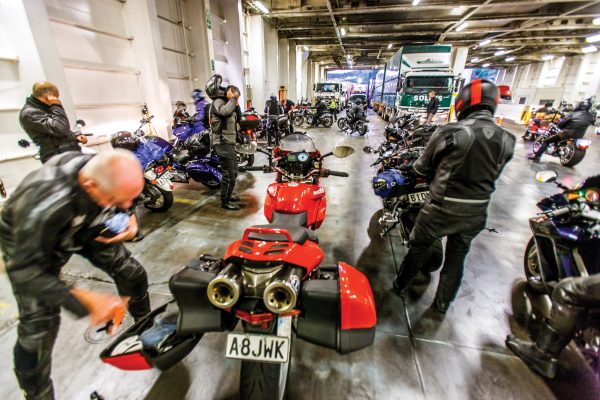
Lewis’ bike is loaded with computers—traction control, wheelie control, launch control—all designed to anticipate, and avert, disaster, but the most sophisticated sensor on the bike is his own brain.
“It’s a head game. I try to approach this with balance: I have a young family and a business with 14 staff. I can’t go out to win at all costs. I ride to my ability, which isn’t always the fastest approach, but it’s the best fit with my life.”
Lewis has done five Burts. This year, beside the street races, he tackled the hill climb at Bluff and the drags and sprints at Teretonga Park.
“The Burt is my favourite,” he says. “There’s no feeling like winning, but when you get beaten by a mate, you don’t mind. The fast guys help out the slow guys. We’re all bitten by the motorcycle bug.”
He’s racing in the BEARS class—British, European, American Racing and Supporters. The snub to the Japanese is more than deliberate; it’s a raison d’être, the founding article of a movement started by another Kiwi motorcycle legend, John Britten.
Comparisons between Britten and Burt Munro are inevitable, and utterly valid: both beat the world with lavish ingenuity and peppercorn budgets. Both refused to settle for second place. Both were, as any Burter would say, good bastards.

The drawcard here today is a rare brace of Brittens—two of only 10 ever made. (Another is on permanent display at Te Papa.) It’s not hard to find the tent: the reverent crowd might be gazing at the Mona Lisa. These bikes are objets d’art, and those prepared to take a stab at their combined worth come up with a cool million.
The Brittens come out for a demonstration lap. Aboard one is Andrew Stroud: nine times New Zealand Superbike Champion, the man who rode a Britten V1000 ahead of many a chasing pack, and in John Britten’s funeral procession in 1995.
“Aren’t we blessed?” the announcer demands. “Two of the greatest bikes in the world, right here in Invercargill.”
When Stroud stands up on the pegs and lifts the front wheel for most of the back straight, the spectators forget about photos and just hoot from the heart.
For the most part, though, the Burt isn’t about greatness. It celebrates instead the human spirit: the tenacity of Munro, the genius of Britten, but most of all, the modest mettle of everyman.
It reserves its highest tributes for those—and there are many—who rode for days to get here, knowing they had no hope of winning. It finds its most noble expression when Kevin Ryan sprawls in the gutter, covered in oil. It laughs along with Colin Halliday and his postie bike, and slaps him on the back. It rouses the loudest cheer when some fallen weekend warrior picks himself up, kicks his bike back into life and takes off in futile pursuit of a distant pack.
As Rob Duncan, the Australian farmer, says: “It’s all about ordinary blokes just having a go.”












